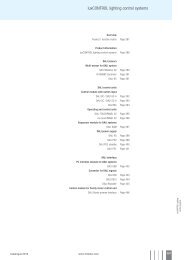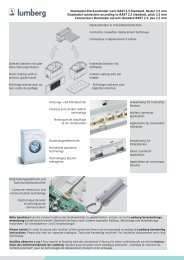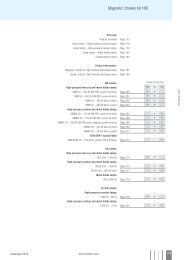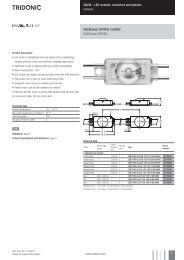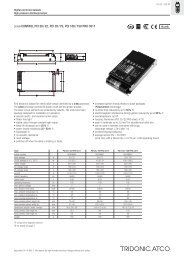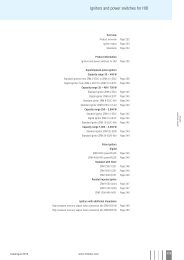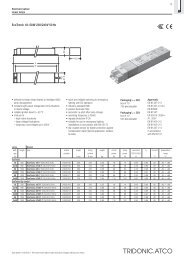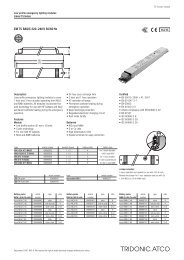PCA T5 EXCEL one4all 24â80 W 220â240 V 50/60/0 Hz, dimmable
PCA T5 EXCEL one4all 24â80 W 220â240 V 50/60/0 Hz, dimmable
PCA T5 EXCEL one4all 24â80 W 220â240 V 50/60/0 Hz, dimmable
Create successful ePaper yourself
Turn your PDF publications into a flip-book with our unique Google optimized e-Paper software.
<strong>T5</strong><br />
Electronic ballasts for dimming to 3 %<br />
Linear lamps <strong>T5</strong>, 16 mm high output<br />
<strong>PCA</strong> <strong>T5</strong> <strong>EXCEL</strong> <strong>one4all</strong> 24–80 W 220–240 V <strong>50</strong>/<strong>60</strong>/0 <strong>Hz</strong>, <strong>dimmable</strong><br />
L<br />
D<br />
4,1<br />
30<br />
28<br />
• dimming range from 1–100 %<br />
• lamp start at 1 % possible<br />
• lamp friendly warm start within 1.5 s with AC<br />
and 0.6 s with DC<br />
• switch via the mains or with digital control signal<br />
• dimming which is comfortable to the eye<br />
• disturbance free precise control with a digital<br />
signal (DSI), switchDIM or DALI (digital<br />
addressable lighting interface)<br />
• error feed back and programmable features<br />
in both DALI and DSI mode<br />
• integrated SMART interface<br />
• fully electronic lamp management and<br />
digital communication with ASIC and µC<br />
• constant light output independent of<br />
fluctuating supply voltage<br />
• DC operation in emergency lighting<br />
installations to VDE 0108<br />
• safe shutdown of defective lamps<br />
• safe shutdown of lamps at end of life<br />
(rectifying effect)<br />
• automatic restart after lamp replacement<br />
• operating frequency ~40–100 k<strong>Hz</strong><br />
Packaging:<br />
box of 25<br />
28 boxes/pallet<br />
700 pieces/pallet<br />
Certified:<br />
EN 5<strong>50</strong>15<br />
EN 5<strong>50</strong>22<br />
EN <strong>60</strong>929<br />
EN 61000-3-2<br />
EN 61347-2-3<br />
EN 61547<br />
in accordance<br />
with VDE 0108<br />
Lamp<br />
Ballast<br />
watt- length type article length fixing weight circuit lamp current λ tc point temperature<br />
age number L centres power power at 230V/<strong>50</strong><strong>Hz</strong> at 230V/<strong>50</strong><strong>Hz</strong> range ➀<br />
W mm D mm kg W ➁ W ➁ A ➁ °C °C<br />
24 549 <strong>PCA</strong> 1/24 <strong>T5</strong> <strong>EXCEL</strong> 220–240V <strong>50</strong>/<strong>60</strong>/0<strong>Hz</strong> 22084922 3<strong>60</strong> 3<strong>50</strong> 0.32 25.8 24 0.12 0.96 70 +10 → +<strong>60</strong><br />
2x24 549 <strong>PCA</strong> 2/24 <strong>T5</strong> <strong>EXCEL</strong> 220–240V <strong>50</strong>/<strong>60</strong>/0<strong>Hz</strong> 22084938 3<strong>60</strong> 3<strong>50</strong> 0.36 51.5 2x24 0.24 0.98 80 +10 → +<strong>60</strong><br />
39 849 <strong>PCA</strong> 1/39 <strong>T5</strong> <strong>EXCEL</strong> 220–240V <strong>50</strong>/<strong>60</strong>/0<strong>Hz</strong> 22084944 3<strong>60</strong> 3<strong>50</strong> 0.32 44.4 39 0.20 0.98 70 +10 → +<strong>60</strong><br />
2x39 849 <strong>PCA</strong> 2/39 <strong>T5</strong> <strong>EXCEL</strong> 220–240V <strong>50</strong>/<strong>60</strong>/0<strong>Hz</strong> 220849<strong>50</strong> 3<strong>60</strong> 3<strong>50</strong> 0.36 90.7 2x39 0.40 0.99 75 +10 → +<strong>50</strong><br />
54 1149 <strong>PCA</strong> 1/54 <strong>T5</strong> <strong>EXCEL</strong> 220–240V <strong>50</strong>/<strong>60</strong>/0<strong>Hz</strong> 22084581 3<strong>60</strong> 3<strong>50</strong> 0.32 <strong>60</strong> 52 0.23 0.98 80 +10 → +<strong>60</strong><br />
2x54 1149 <strong>PCA</strong> 2/54 <strong>T5</strong> <strong>EXCEL</strong> 220–240V <strong>50</strong>/<strong>60</strong>/0<strong>Hz</strong> 22084597 3<strong>60</strong> 3<strong>50</strong> 0.36 116 2x52 0.<strong>50</strong> 0.99 75 +10 → +<strong>50</strong><br />
80 1449 <strong>PCA</strong> 1/80 <strong>T5</strong> <strong>EXCEL</strong> 220–240V <strong>50</strong>/<strong>60</strong>/0<strong>Hz</strong> 22084963 3<strong>60</strong> 3<strong>50</strong> 0.32 89.5 80 0.36 0.98 75 +10 → +<strong>50</strong><br />
➀ dimming to 3 % (10 % with 80 W) between 10 °C to ta max.<br />
➁ valid at 100 % light output<br />
Data sheet 08/07-387-2 We reserve the right to make technical changes without prior notice.
Electronic ballasts for dimming to 3 %<br />
Linear lamps <strong>T5</strong>, 16 mm high output<br />
Lamp starting characteristics:<br />
Warm start<br />
Starting time 1,5s with AC<br />
Starting time 0,6s with DC<br />
Start at any dimming level<br />
AC-operation:<br />
Mains Voltage<br />
220–240 V <strong>50</strong>/<strong>60</strong> <strong>Hz</strong><br />
198–264 V <strong>50</strong>/<strong>60</strong> <strong>Hz</strong> including safety<br />
tolerance (±10 %)<br />
202–254 V <strong>50</strong>/<strong>60</strong> <strong>Hz</strong> including safety<br />
tolerance (+6 % / -8 %)<br />
DC-operation:<br />
220–240 V 0 <strong>Hz</strong><br />
198–280 V 0 <strong>Hz</strong> certain lamp start<br />
176–280 V 0 <strong>Hz</strong> operating range<br />
Use in emergency lighting installations according to<br />
VDE 0108 or for emergency luminaires according to<br />
EN 61347-2-3 appendix J.<br />
Temperature range:<br />
Dimming range 100 % to 3 % (100 % to 10 %<br />
with 80 W) von 10 °C to maximum permissible<br />
ambient temperature ta.<br />
Mains currents in DC operation<br />
Ballast Mains current at Mains current at<br />
Typ U n = 220 VDC U n = 240 VDC<br />
<strong>PCA</strong> 1/24 <strong>T5</strong> <strong>EXCEL</strong> 220–240V <strong>50</strong>/<strong>60</strong>/0<strong>Hz</strong> 0,10 A 0,10 A<br />
<strong>PCA</strong> 1/39 <strong>T5</strong> <strong>EXCEL</strong> 220–240V <strong>50</strong>/<strong>60</strong>/0<strong>Hz</strong> 0,16 A 0,15 A<br />
<strong>PCA</strong> 1/54 <strong>T5</strong> <strong>EXCEL</strong> 220–240V <strong>50</strong>/<strong>60</strong>/0<strong>Hz</strong> 0,24 A 0,21 A<br />
<strong>PCA</strong> 1/80 <strong>T5</strong> <strong>EXCEL</strong> 220–240V <strong>50</strong>/<strong>60</strong>/0<strong>Hz</strong> 0,34 A 0,31 A<br />
<strong>PCA</strong> 2/24 <strong>T5</strong> <strong>EXCEL</strong> 220–240V <strong>50</strong>/<strong>60</strong>/0<strong>Hz</strong> 0,20 A 0,18 A<br />
<strong>PCA</strong> 2/39 <strong>T5</strong> <strong>EXCEL</strong> 220–240V <strong>50</strong>/<strong>60</strong>/0<strong>Hz</strong> 0,33 A 0,30 A<br />
<strong>PCA</strong> 2/54 <strong>T5</strong> <strong>EXCEL</strong> 220–240V <strong>50</strong>/<strong>60</strong>/0<strong>Hz</strong> 0,42 A 0,38 A<br />
Light output level in DC operation:<br />
Programmable from 3 % to 70 %<br />
Programming by extended DSI-Signal (16 Bit)<br />
Default value 70 %<br />
In DC Operation dimming is not possible<br />
Ballast lumen factor AC operation (AC-BLF) EN <strong>60</strong>929 Pkt.8.1:<br />
Ballast AC-BLF at Typ U n = 230 VAC<br />
<strong>PCA</strong> 1/24 <strong>T5</strong> <strong>EXCEL</strong> 220–240V <strong>50</strong>/<strong>60</strong>/0<strong>Hz</strong> 0,96<br />
<strong>PCA</strong> 1/39 <strong>T5</strong> <strong>EXCEL</strong> 220–240V <strong>50</strong>/<strong>60</strong>/0<strong>Hz</strong> 0,95<br />
<strong>PCA</strong> 1/54 <strong>T5</strong> <strong>EXCEL</strong> 220–240V <strong>50</strong>/<strong>60</strong>/0<strong>Hz</strong> 0,97<br />
<strong>PCA</strong> 1/80 <strong>T5</strong> <strong>EXCEL</strong> 220–240V <strong>50</strong>/<strong>60</strong>/0<strong>Hz</strong> 1,12<br />
<strong>PCA</strong> 2/24 <strong>T5</strong> <strong>EXCEL</strong> 220–240V <strong>50</strong>/<strong>60</strong>/0<strong>Hz</strong> 1,00<br />
<strong>PCA</strong> 2/39 <strong>T5</strong> <strong>EXCEL</strong> 220–240V <strong>50</strong>/<strong>60</strong>/0<strong>Hz</strong> 0,97<br />
<strong>PCA</strong> 2/54 <strong>T5</strong> <strong>EXCEL</strong> 220–240V <strong>50</strong>/<strong>60</strong>/0<strong>Hz</strong> 0,98<br />
The ballast lumen factor for AC operation (AC-BLF) does not alter from U n = 198 VAC bis<br />
U n = 254 VAC.<br />
The ballast lumen factor for DC operatino (DC-BLF) on the basis of an automativ power reduction<br />
of the ballasts (default value is 70%) will be smaller than AC. It does not alter inthe DC operating<br />
range (198–280 VDC).<br />
Harmonic distortion in the mains supply (at 220 V / <strong>50</strong> <strong>Hz</strong>):<br />
Ballast<br />
Typ THD 3 5 7 9 11<br />
<strong>PCA</strong> 1/24 <strong>T5</strong> <strong>EXCEL</strong> 220–240V <strong>50</strong>/<strong>60</strong>/0<strong>Hz</strong> 9,9 9,5 2,4 1,5 0,9 0,8<br />
<strong>PCA</strong> 1/39 <strong>T5</strong> <strong>EXCEL</strong> 220–240V <strong>50</strong>/<strong>60</strong>/0<strong>Hz</strong> 8,7 8,2 2,4 1,5 1,0 0,8<br />
<strong>PCA</strong> 1/54 <strong>T5</strong> <strong>EXCEL</strong> 220–240V <strong>50</strong>/<strong>60</strong>/0<strong>Hz</strong> 7,1 6,4 2,5 1,6 1,2 0,8<br />
<strong>PCA</strong> 1/80 <strong>T5</strong> <strong>EXCEL</strong> 220–240V <strong>50</strong>/<strong>60</strong>/0<strong>Hz</strong> 7,2 6,7 2,3 1,6 1,2 0,8<br />
<strong>PCA</strong> 2/24 <strong>T5</strong> <strong>EXCEL</strong> 220–240V <strong>50</strong>/<strong>60</strong>/0<strong>Hz</strong> 6,6 6,1 2,0 1,3 0,9 0,6<br />
<strong>PCA</strong> 2/39 <strong>T5</strong> <strong>EXCEL</strong> 220–240V <strong>50</strong>/<strong>60</strong>/0<strong>Hz</strong> 7,4 7,0 2,0 1,2 0,8 0,7<br />
<strong>PCA</strong> 2/54 <strong>T5</strong> <strong>EXCEL</strong> 220–240V <strong>50</strong>/<strong>60</strong>/0<strong>Hz</strong> 6,5 6,1 2,0 1,2 0,9 0,7<br />
2 Data sheet 08/07-387-2 We reserve the right to make technical changes without prior notice.
Electronic ballasts for dimming to 3 %<br />
Linear lamps <strong>T5</strong>, 16 mm high output<br />
Dimming:<br />
Dimming range 3 % bis 100 %<br />
(10 % bis 100 % bei 80 W)<br />
Digital control with<br />
• DSI-Signal: 8 Bit Manchester Code<br />
Maximum speed 3 % to 100 % (10 % to 100 %<br />
bei 80 W) in 1,4 s<br />
• DALI-Signal: 16 Bit Manchester Code<br />
Maximum speed 3 % to 100 % (10 % to100 % bei<br />
80 W) in 0,5 s<br />
Programmable parameter:<br />
Minimum dimming level<br />
Maximum dimming level<br />
Default minimum = 3 %<br />
(10 % bei 80 W)<br />
Programmable Range 3 % ≤ MIN ≤ 49 %<br />
(10 % ≤ MIN ≤ 49 % bei 80 W)<br />
Default Maximum = 100 %<br />
Programmable Range 100 % ≥ MAX ≥ <strong>50</strong> %<br />
Dimming curve that is friendly to the eye<br />
Dimming characteristics <strong>PCA</strong> <strong>EXCEL</strong><br />
Digital dimming value<br />
255<br />
225<br />
200<br />
DALI<br />
175<br />
DSI<br />
1<strong>50</strong><br />
125<br />
100<br />
75<br />
<strong>50</strong><br />
25<br />
0<br />
0 10 20 30 40 <strong>50</strong> <strong>60</strong> 70 80 90 100<br />
Relative lighting level %<br />
Dimming characteristics as seen by the human eye<br />
Energy Savings <strong>PCA</strong> <strong>EXCEL</strong><br />
Mains power in %<br />
100<br />
90<br />
80<br />
70<br />
<strong>60</strong><br />
<strong>50</strong><br />
40<br />
30<br />
20<br />
10<br />
0<br />
100 90 80 70 <strong>60</strong> <strong>50</strong> 40 30 20 15 10 5 4 3 2 1<br />
Dimming level in %<br />
Control input (DA/D1, DA/D2):<br />
Digital DALI/DSI signal or switchDIM can be wired<br />
on the same terminals (DA/D1 and DA/D2).<br />
Digital signal DALI/DSI:<br />
The control input is non-polar and protected<br />
against accidental connection with a mains<br />
voltage up to 264 V. The control signal is not<br />
SELV. Control cable should be installed in<br />
accordance to the requirements of low voltage<br />
installations.<br />
Different functions depending on each module.<br />
SMART interface:<br />
An additional interface for the direct connection of<br />
the SMART-LS light sensor. The sensor registers<br />
actual ambient light and maintains the individually<br />
defined lux level.<br />
After every mains reset the SMART interface automatically<br />
checks for an installed sensor. With the<br />
sensor installed the <strong>PCA</strong> <strong>EXCEL</strong> automatically runs<br />
in the constant lux level mode.<br />
ON/OFF-Switch via mains, switchDIM or DALI/DSI<br />
signal.<br />
DALI/DSI signal = 0 switches off,<br />
DALI/DSI signal ≥ 1 switches on.<br />
Dimming with DALI or a DSI signal with the<br />
SMART-LS installed is not possible.<br />
switchDIM enables a temporary change of<br />
light level.<br />
The installation of the two wire bus is according<br />
to the appropriate low voltage regulations.<br />
switchDIM:<br />
Integrated switchDIM function allows a direct<br />
connection of a push to make switch for dimming<br />
and switching.<br />
Brief push (< 0.6 s) switches ballast ON and OFF.<br />
The ballasts switch-ON at light level set at switch-<br />
OFF.<br />
When the push to make switch is held, <strong>PCA</strong><br />
ballasts are dimmed. After repush the <strong>PCA</strong> is<br />
dimmed in the opposite direction.<br />
In installations with <strong>PCA</strong>s with different dimming<br />
levels or opposite dimming directions (e.g. after a<br />
system extension), all <strong>PCA</strong>s can be synchronized<br />
to <strong>50</strong> % dimming level by a 10 s push.<br />
Use of push to make switch with indicator lamp is<br />
not permitted.<br />
DALI<br />
DALI <strong>PCA</strong> <strong>T5</strong> <strong>EXCEL</strong> <strong>one4all</strong><br />
DSI<br />
2<br />
3<br />
4<br />
6<br />
7<br />
DSI <strong>PCA</strong> <strong>T5</strong> <strong>EXCEL</strong> <strong>one4all</strong><br />
N<br />
L<br />
2<br />
3<br />
4<br />
6<br />
7<br />
2<br />
3<br />
4<br />
6<br />
7<br />
DA / D1<br />
DA / D2<br />
DA / D1<br />
DA / D2<br />
DA / D1<br />
DA / D2<br />
switchDIM <strong>PCA</strong> <strong>T5</strong> <strong>EXCEL</strong> <strong>one4all</strong><br />
Loading of automatic circuit breakers:<br />
Automatic circuit C10 C13 C16 C20 B10 B13 B16 B20<br />
Installation ∅ 1,5 mm 2 1,5 mm 2 1,5 mm 2 2,5 mm 2 1,5 mm 2 1,5 mm 2 1,5 mm 2 2,5 mm 2<br />
<strong>PCA</strong> 1/24 <strong>T5</strong> <strong>EXCEL</strong> 22 32 44 <strong>50</strong> 11 16 22 25<br />
<strong>PCA</strong> 1/39 <strong>T5</strong> <strong>EXCEL</strong> 22 32 44 <strong>50</strong> 11 16 22 25<br />
<strong>PCA</strong> 1/54 <strong>T5</strong> <strong>EXCEL</strong> 22 32 44 <strong>50</strong> 11 16 22 25<br />
<strong>PCA</strong> 1/80 <strong>T5</strong> <strong>EXCEL</strong> 10 20 30 30 5 10 15 15<br />
<strong>PCA</strong> 2/24 <strong>T5</strong> <strong>EXCEL</strong> 22 32 46 52 11 16 23 26<br />
<strong>PCA</strong> 2/39 <strong>T5</strong> <strong>EXCEL</strong> 14 22 28 34 7 11 14 17<br />
<strong>PCA</strong> 2/54 <strong>T5</strong> <strong>EXCEL</strong> 14 22 28 34 7 11 14 17<br />
Data sheet 08/07-387-2 We reserve the right to make technical changes without prior notice.<br />
3
Electronic ballasts for dimming to 3 %<br />
Linear lamps <strong>T5</strong>, 16 mm high output<br />
Installation instructions:<br />
Wiring type and cross section:<br />
The wiring can be solid cable with a cross section<br />
of 0.5 to 1.5 mm² for push terminal and 0.5 mm²<br />
for concut terminal. For the push-wire connection<br />
you have to strip the insulation (7.5–8.5 mm).<br />
Wiring advice:<br />
The lead length is dependent on the capacitance of the cable.<br />
Ballast Terminal Maximum capacitance allowed<br />
Type Cold Hot Cold Hot<br />
<strong>PCA</strong> 1/xx <strong>T5</strong> <strong>EXCEL</strong> 11, 12 9, 10 200 pF 100 pF<br />
<strong>PCA</strong> 2/xx <strong>T5</strong> <strong>EXCEL</strong> 11, 12, 13, 14 9, 10, 15, 16 200 pF 100 pF<br />
wire preparation:<br />
0.5 – 1.5<br />
With standard solid wire 0.5/0.75 mm² the<br />
capacitance of the lead is 30–80 pF/m.<br />
This value is influenced by the way the wiring<br />
is made.<br />
Lamp connection should be made with<br />
symmetrical wiring.<br />
Hot leads (9, 10, 15, 16) and cold leads (11, 12,<br />
13, 14) should be separated as much as possible.<br />
7.5 – 8.5 mm<br />
* * control signal<br />
2<br />
3<br />
4<br />
6<br />
7<br />
DA / D1<br />
DA / D2<br />
12<br />
11<br />
10<br />
9<br />
Ballast<br />
Typ<br />
U out<br />
<strong>PCA</strong> 1/24 <strong>T5</strong> <strong>EXCEL</strong> 220–240V <strong>50</strong>/<strong>60</strong>/0<strong>Hz</strong> 2<strong>50</strong> V 2<strong>50</strong><br />
<strong>PCA</strong> 1/39 <strong>T5</strong> <strong>EXCEL</strong> 220–240V <strong>50</strong>/<strong>60</strong>/0<strong>Hz</strong> 2<strong>50</strong> V 2<strong>50</strong><br />
<strong>PCA</strong> 1/54 <strong>T5</strong> <strong>EXCEL</strong> 220–240V <strong>50</strong>/<strong>60</strong>/0<strong>Hz</strong> 3<strong>50</strong> V 3<strong>50</strong><br />
<strong>PCA</strong> 1/80 <strong>T5</strong> <strong>EXCEL</strong> 220–240V <strong>50</strong>/<strong>60</strong>/0<strong>Hz</strong> 400 V 400<br />
<strong>PCA</strong> 2/24 <strong>T5</strong> <strong>EXCEL</strong> 220–240V <strong>50</strong>/<strong>60</strong>/0<strong>Hz</strong> 2<strong>50</strong> V 2<strong>50</strong><br />
<strong>PCA</strong> 2/39 <strong>T5</strong> <strong>EXCEL</strong> 220–240V <strong>50</strong>/<strong>60</strong>/0<strong>Hz</strong> 2<strong>50</strong> V 2<strong>50</strong><br />
<strong>PCA</strong> 2/54 <strong>T5</strong> <strong>EXCEL</strong> 220–240V <strong>50</strong>/<strong>60</strong>/0<strong>Hz</strong> 3<strong>50</strong> V 3<strong>50</strong><br />
RFI:<br />
• Connection to the lamps of the hot leads must<br />
be kept as short as possible<br />
• Mains leads should be kept apart from lamp<br />
leads (ideally 5–10 cm distance)<br />
• Do not run mains leads adjacent to the<br />
electronic ballast<br />
• Twist the lamp leads<br />
• Keep the distance of lamp leads from the<br />
metal work as large as possible<br />
• Ballast must be earthed<br />
• Mains wiring to be twisted when through wiring<br />
• Keep the mains leads inside the luminaire as<br />
short as possible<br />
<strong>PCA</strong> <strong>T5</strong> <strong>EXCEL</strong> <strong>one4all</strong> 24–80 W<br />
* * control signal<br />
* leads 9, 10: keep wires short, max. 1.0 m<br />
leads 11, 12: max. 2.0 m; ballast must be earthed<br />
* * digital signal (DSI), DALI or switchDIM<br />
2<br />
3<br />
4<br />
6<br />
7<br />
DA / D1<br />
DA / D2<br />
<strong>PCA</strong> <strong>T5</strong> <strong>EXCEL</strong> <strong>one4all</strong> 2x24–2x54 W<br />
16<br />
15<br />
14<br />
13<br />
12<br />
11<br />
10<br />
9<br />
* leads 9, 10, 15, 16: keep wires short, max. 1.0 m<br />
leads 11, 12, 13, 14: max. 2.0 m; ballast must be earthed<br />
* * digital signal (DSI), DALI or switchDIM<br />
Important advise:<br />
• When using two or more <strong>dimmable</strong> ballasts in<br />
one luminaire with separate dimming controls,<br />
the lamp leads must be kept separate<br />
• All lamps must have the same length lead<br />
Data sheet 08/07-387-2 We reserve the right to make technical changes without prior notice.





